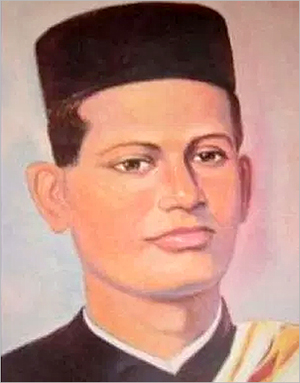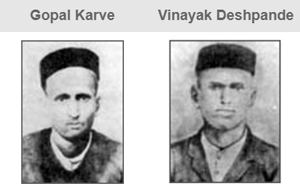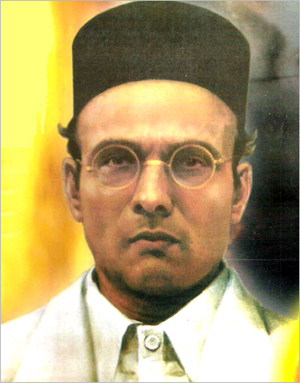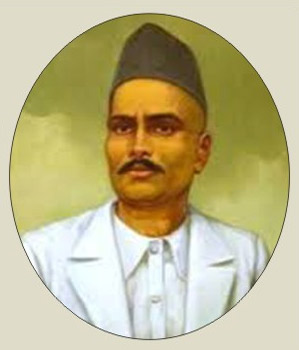 21st December 1909. Anant Kanhere shot the collector Jackson in Vijayanand theater. The murder of Jackson challenged the British Rule. The people involved in the incidence, Anant Laxman Kanhere, Krishnaji Gopal Karve and Vinayak Ramchandra Deshpande were sentenced to death. It wasduring this time that ‘Abhinav Bharat’ was formed. The young Nashikites were influenced by the speech of Lokmanya Tilak given on the 26th of August 1906. Veer Savarkar successfully organised underground movement against the rulers.
21st December 1909. Anant Kanhere shot the collector Jackson in Vijayanand theater. The murder of Jackson challenged the British Rule. The people involved in the incidence, Anant Laxman Kanhere, Krishnaji Gopal Karve and Vinayak Ramchandra Deshpande were sentenced to death. It wasduring this time that ‘Abhinav Bharat’ was formed. The young Nashikites were influenced by the speech of Lokmanya Tilak given on the 26th of August 1906. Veer Savarkar successfully organised underground movement against the rulers.
The revolutionary activities at Nashik however continued. Although elaborately planned & very cautiously carried out they came to be suddenly interrupted on account of the hot-headed, intemperate & hasty on the part of a group of young men from Aurangabad, who involved some of the weaker members of the Mitra-Mela in their plan.  Of these hot-headed persons one Anant Kanhere came to Nashik & on the night of 21st December 1909 suddenly fired at Mr. Jackson, the collector of Nashik when the latter had gone to see a drama ‘Sharada’ stagd by Kirlosker Natak Mandali in the local Vijayanand theater. The collector died on the spot. This set a whole chain of government inquiry into vigorous activity, the result of which was that all those connected with underground activities in the name of Mitra-Mela, including Savarkar, who at that time had been in India came to be arrested, tried & sentenced to severe punishments. The embers of revolution flared , in those days, into Marathi songs full of patriotic fervour written by various writers, prominent among whom was G.T. Darekar popularly called ‘Govind Kavi’ whose poems such as ‘Who could ever win freedom without fight ?’ or addressing his prayer to God Rama & saying ‘When, O Rama, wilt thou be pleased to satisfy our burning desire for freedom,
Of these hot-headed persons one Anant Kanhere came to Nashik & on the night of 21st December 1909 suddenly fired at Mr. Jackson, the collector of Nashik when the latter had gone to see a drama ‘Sharada’ stagd by Kirlosker Natak Mandali in the local Vijayanand theater. The collector died on the spot. This set a whole chain of government inquiry into vigorous activity, the result of which was that all those connected with underground activities in the name of Mitra-Mela, including Savarkar, who at that time had been in India came to be arrested, tried & sentenced to severe punishments. The embers of revolution flared , in those days, into Marathi songs full of patriotic fervour written by various writers, prominent among whom was G.T. Darekar popularly called ‘Govind Kavi’ whose poems such as ‘Who could ever win freedom without fight ?’ or addressing his prayer to God Rama & saying ‘When, O Rama, wilt thou be pleased to satisfy our burning desire for freedom,
 The tempo in singing such songs in congregation used to enliven the audience & strengthen their determination to face the struggle. Subsequently government banned all such songs & suppressed all undrground activities with a heavy hand. The government had become very sensitive & even an utterance here or there or a display of an objectionable picture led to extreme government action. A few examples would suffice. Shri Khare, a pleader in Nashik, was accused to havesaid the following a few days before the murder of Mr. Jackson : “Today 4 crores of people rule over 33 crores & they have destroyed Indian industries.” “It is the businessof the white to ruin us black people”. “europeans are like the demon ghost Putana, who was fair outside but poisonous within”. “The time for action has come. How many of you ae ready to go to jail or to die?” & the like. Shri Khare was asked to submit a personal bond failing which the High Court recommended that his sanad should be suspended till such time that the order to furnish security continues in force Another interesting case was that of Shridhar Waman Nagarkar of Nashik who was sentenced to three years’ rigorous imprisonment for drawing & publishing a picture containing a mythological representation of the slaying of demon Mahish by the Goddess Durga, framed with portrails of certain persons, notorious for sedition. The government took the view that the picture is likely to excite disaffection towards His Majesty or the government established by law in British India. Similar was the case against Devising Mohansing & Shankar Gir Hanumantgir of Nashik for publishing a seditious picture under the title “Rashtra Purusha”. The former was sentenced to three years’ rigorous imprisonment. Given below are the details of Jackson murder case that resulted in the subsequent unrest & discontent –
The tempo in singing such songs in congregation used to enliven the audience & strengthen their determination to face the struggle. Subsequently government banned all such songs & suppressed all undrground activities with a heavy hand. The government had become very sensitive & even an utterance here or there or a display of an objectionable picture led to extreme government action. A few examples would suffice. Shri Khare, a pleader in Nashik, was accused to havesaid the following a few days before the murder of Mr. Jackson : “Today 4 crores of people rule over 33 crores & they have destroyed Indian industries.” “It is the businessof the white to ruin us black people”. “europeans are like the demon ghost Putana, who was fair outside but poisonous within”. “The time for action has come. How many of you ae ready to go to jail or to die?” & the like. Shri Khare was asked to submit a personal bond failing which the High Court recommended that his sanad should be suspended till such time that the order to furnish security continues in force Another interesting case was that of Shridhar Waman Nagarkar of Nashik who was sentenced to three years’ rigorous imprisonment for drawing & publishing a picture containing a mythological representation of the slaying of demon Mahish by the Goddess Durga, framed with portrails of certain persons, notorious for sedition. The government took the view that the picture is likely to excite disaffection towards His Majesty or the government established by law in British India. Similar was the case against Devising Mohansing & Shankar Gir Hanumantgir of Nashik for publishing a seditious picture under the title “Rashtra Purusha”. The former was sentenced to three years’ rigorous imprisonment. Given below are the details of Jackson murder case that resulted in the subsequent unrest & discontent –
 The evidence in this case establishes that prior to the year 1906, an association of young men , mostly Brahmans, existed in Nashik under leadership of Ganesh & Vinayak Savarkar which was known as the Mitra-Mela. In it were reproduced the features of other similar associations in the Deccan to which reference has already been made. Exciting songs were prepared for the Ganpati and Shivaji festivals & the members of the Mitra-Mela used to join in singing these songs either in procession or in the precincts of some temple or other place of assembly.
The evidence in this case establishes that prior to the year 1906, an association of young men , mostly Brahmans, existed in Nashik under leadership of Ganesh & Vinayak Savarkar which was known as the Mitra-Mela. In it were reproduced the features of other similar associations in the Deccan to which reference has already been made. Exciting songs were prepared for the Ganpati and Shivaji festivals & the members of the Mitra-Mela used to join in singing these songs either in procession or in the precincts of some temple or other place of assembly.
Physical instruction was given to members by one of the witnesses in this case & by a Mahomedan brought for the purpose from Baroda. The activities of the association did not, however, cease there, for we have evidence, which we accept as true, that meetings were held at the house of Ganesh Savarkar & of Aba Darekar, one of the song-writers of the association, at which the biographies of patriotic revolutionists were read & re-read, the particular favourites being Mazzini, Shivaji & Ramdas & where discusssions were carried on with regard to the means for attaining independence for India. At these meetings the methods advocated were the education of public by means of lectures, books & songs, & the preparation for rising against the British Government by collection of arms & ammunition.
We have examples of inflammatory speeches delivered by Vinayak & Narayan Savarkar & by Mahadev Bhat, & a photograph of number of members of the Mitra Mela, several of whom are among the accused, grouped round Vinayak Savarkar in which four or five pictures of Shivaji, A board bearing the words “Bande Mataram” & a book bearing the name of Mazzini on the outer cover are prominently displayed, which corroborate the general description of the aims & methods of the association given by the witnesses.
The photograph Exhibit A-271, to which referance has been made, marks an important stage in the history of the association. Its occasion was the impending departure of Vinayak Savarkar for England in the middle of June 1906, a step which he was enabled to take owing to his being the recipent of a scholarship given by Shamji Krishna Varma, the founder of the India House at Highgate. Up to the time of his departure Vinayak Savarkar had been one of the most active & probably the most stimulating of the members of the Mitra Mela. In the early part of 1906 speeches were delivered by him in Poona & in nashik the object of which was to arouse the country & to suggest how by means of mental training & physical exercises, preparation might be made for successful revolt.
 Before the departure of Vinayak Savarkar the Mitra Mela had developed into or given birth to the Abhinav Bharat or Young India Society a title which the prosecution suggests was borrowed from the “Young Italy” of Muzzini. Its objects were unquestionably revolutionary.
Before the departure of Vinayak Savarkar the Mitra Mela had developed into or given birth to the Abhinav Bharat or Young India Society a title which the prosecution suggests was borrowed from the “Young Italy” of Muzzini. Its objects were unquestionably revolutionary.
The aim of its members was to be prepared for war. The list of objects enumerated in Exhibit 9B found in the possession of Kashikar in 1909 affords ample corroboration of the evidence of witnesses upon this point.
The books of verse composed by members of the socitey known as the “Laghu Abhinav Bharat Mala” were printed & published in Bombay & Sholapur & were for a long time openly sold though of a most inflammatory character. The publisher of four of the earlier issues of the above series departure for England in 1906 & an edition of 5,000 copies was published in September of that year.
 This series of publications culminated in 1908 with the issue by Ganesh Savarkar of Fiowers 8 & 9 containing a clear incitement to war against the British. They resulted in the arrest of Ganesh Savarkar on the 28th February 1909 & his subsequent conviction & transportation but not before he had made arrangements for the reception in Bombay of a consignment of Browning pistols which were originally destined for Nashik.
This series of publications culminated in 1908 with the issue by Ganesh Savarkar of Fiowers 8 & 9 containing a clear incitement to war against the British. They resulted in the arrest of Ganesh Savarkar on the 28th February 1909 & his subsequent conviction & transportation but not before he had made arrangements for the reception in Bombay of a consignment of Browning pistols which were originally destined for Nashik.